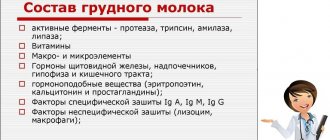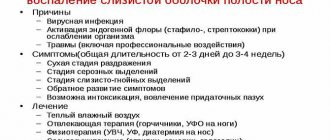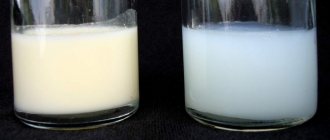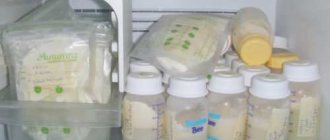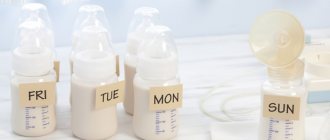Woman's milk is a special product that is formed during the lactation period through the active work of the alveoli. They are located in the mammary glands and receive useful components from the blood and lymph. Food undergoes decomposition in the gastrointestinal tract, and then its individual nutritional parts penetrate into the blood. The molecules begin their active movement towards the mammary gland, through which they penetrate directly into the product itself. The process takes some time. It is important for a woman to know how long it takes for food to pass into breast milk.
Thanks to this knowledge, mommy will be able to avoid serious consequences in the baby’s body. Any product eaten can lead to the development of diathesis or even allergies. Information will help not harm the child, because every person periodically, for example, wants to drink a glass of champagne on a holiday. It is impossible to completely exclude the possibility of mommy getting sick, which will require taking medications. In this case, it is advisable to do everything to prevent the development of serious complications in the baby’s body.
Medicines and food affect the body differently. The procedure for processing them also varies. However, each of these processes should be considered separately.
Features of the sugar conversion process
If a woman has eaten any product that contains glucose, it will appear in the blood in just 10 minutes. However, sugar is also eliminated quickly - within half an hour. Sweets have a positive effect directly on the taste of milk. The process occurs most quickly if the woman has eaten sugar in its pure form. The same effect will occur if you eat honey, jam and grapes. The baby’s body is not yet ready for such a test, so it cannot cope with the breakdown of this complex component. Therefore, the baby may experience bloating and colic. If a woman eats too much sugar, a rash is guaranteed to appear on the skin.
Alcohol during breastfeeding
Pediatricians in America and Europe allow women who have given birth to drink red wine. The Russian situation is absolutely the opposite, doctors are categorically against it, so young mothers have a question: how long after drinking alcohol can they breastfeed?
Any alcohol contains ethyl alcohol, which is dangerous for the baby. This alcohol is transferred to the blood after only 3 minutes, and the elimination time depends on the amount drunk and the strength of the drink, then milk can be dangerous for a child up to 2 days. The elimination time depends on the amount drunk, and also individually on the body, some may drink a glass and find themselves drunk because of it, others will need 2 liters of wine.
We recommend reading: Packages for freezing breast milk
Foods with an increased risk of gas formation
According to most mothers, foods that lead to the accumulation of gas in the intestines can harm the baby. Additionally, it should be noted that the bloating product cannot be absorbed into the internal organs or blood. That is why such food cannot negatively affect the baby’s body. Colic and gas are products of the breakdown of large amounts of protein food. They lead to stomach upset and poor health of the baby. Pediatricians recommend completely abstaining from their use during lactation.
Anatomy of the mammary glands
Breast development begins in the womb, from approximately the fourth to the seventh week, when thickening of the skin in the armpit of the embryo is noticeable. From the sixteenth to the twenty-fourth week, such folds will disappear, leaving behind the rudiments of the mammary glands. Subsequently, they are transformed into milk ducts and alveoli, which store milk. Rapid changes in the mammary glands are observed during puberty, but doctors consider full maturation only after childbirth and full production of breast milk. The breast consists mainly of glandular tissue, the main purpose of which is the production and transportation of milk. Connective tissue performs a supporting function, and the delivery of nutrients is provided by the blood. Waste elements are eliminated through the lymphatic system. Also directly involved are nerve endings that transmit and receive impulses, and fat that protects the mammary glands from damage. Glandular tissue contains many alveoli. Their function is to store and “dispense” milk. The expulsion of milk occurs due to the compression of small muscle cells around the alveoli. The alveolar ducts connect into larger structures that carry milk out through small openings in the nipples.
We open up the question: Solving the problem of constipation in newborns during breastfeeding
Allergens in food
Some substances can cause individual intolerance in the body of a child or woman. Their effect can be noticed just forty minutes after entering the body. The removal process will take much longer. This period is fixed at three to fifteen hours. Each group of allergens has its own period of final elimination from the body:
- Dishes based on dairy ingredients – 4 hours.
- Sweet or yeast products – 15 hours.
- Vegetables – 8 hours.
Today there are a huge number of products that contain the E-component. It can stay in the blood for up to one week.
Allergens are dangerous because they lead to the active formation of histamine. In an infant, it is most often formed under the influence of honey, citrus fruits, eggs, and some vegetables or fruits. Eating them in large quantities is contraindicated. Cow's milk or seafood can also have a negative effect. If the allergy is not acute, then it makes sense to gradually accustom the child to the product. Dishes are given in small quantities and rarely.
The health of the baby directly depends on the mother's diet
However, there are also products that enter the body and provoke an acute allergic reaction.
We recommend reading: Diet for a nursing mother of a newborn
It is best to avoid using them:
- Crackers and chips contain large amounts of glutamates. They are dangerous for the infant’s fragile body.
- Vitamins that were obtained through synthesis or extracts from herbs can also have a negative effect.
- Unfortunately, today nitrates have begun to appear more and more often in vegetables and fruits. Red fruits should be avoided.
- Aspirin is an ingredient in lemonade and other drinks. They should be avoided during breastfeeding.
Iron
Mother's milk contains a sufficient amount of iron, regardless of the amount of iron received from food. From the moment of consuming food containing iron until it passes into breast milk, 2 to 4 hours pass.
Some babies experience impaired iron absorption. This condition threatens the appearance of iron deficiency anemia. To replenish iron reserves, a nursing woman is recommended to consume the following foods:
- red meat;
- liver and offal;
- apples and apple juice;
- parsley;
- Jerusalem artichoke;
- beet.
If a child experiences a lack of iron, doctors prescribe complementary feeding.
After the birth of the baby, every woman receives recommendations that help to establish the breastfeeding process with maximum benefit for mother and child. Subscribe to our VKontakte group
Alcoholic drinks
If you drink this product, its components will appear in the blood in just five minutes. Against this background, a person develops alcohol intoxication. The results of decomposition will remain in the blood for another two days. Portion size, amount of alcohol and mommy’s weight play an important role. The speed of metabolic processes in the body should also be taken into account.
Some women mistakenly believe that if they express milk, then all the alcohol is guaranteed to leave the body. However, it is not. Alcohol tends to accumulate in the blood. It has a detrimental effect on the walls of the alveoli. This is why alcohol will be present in breast milk for several days. Pediatricians don’t even require him to express it. Alcohol molecules tend to move to the part of the body where they are least concentrated at the moment. Additionally, it should be noted that breast milk tends to be renewed regularly.
Alcohol should not be drunk during lactation
How to act as a mother
Often mothers make the same mistake - they express themselves so that the food they eat does not enter the baby’s body. Pumping will not help in this case. You can clearly see the principle of action and removal of chemicals from the body using the example of a medicine.
If you take a pill that works for 4 hours, then that is how long its active ingredient will remain in the body. It will be distributed in the blood and will be detected in other biological fluids (pass into breast milk).
Gradually, the amount of active substance in the body will decrease. After 2 hours there will be half as much of it in blood and breast milk. After 4 hours, the tablet will stop working and will be completely eliminated from the body. If you express milk during this time, the tablet will not work for 2 hours instead of 4. A similar rule applies to component products.
You can speed up the removal of food components using sorbents. These drugs only work in the intestines and do not enter the bloodstream. They cleanse the body of toxins, chemicals and other compounds. In addition to toxins and harmful components, sorbents remove vitamins, minerals and other beneficial components.
Vitamin complexes
Beneficial substances can enter the body along with food. If the mother eats properly, then the child is guaranteed to grow and develop correctly. Today, vitamins that can be dissolved in plain water are very popular. These include ascorbic acid, thiamine and pyridoxine. These components cannot accumulate in the body, so they must be supplied daily.
To ensure this process, it is advisable to include the following foods in your diet:
- Sufficient amounts of ascorbic acid are present in citrus fruits, rose hips, parsley, cranberries and cabbage.
- Nicotinic acid enters the body along with liver, seafood, chicken, pork, carrots, beans or mint.
- You can find thiamine in beef and pork. It is also found in sufficient quantities in liver, spinach, peas and beans.
- To supply riboflavin to the gastrointestinal tract, you need to eat more mushrooms, mackerel, eggs, cottage cheese, almonds, spinach and rose hips.
- Pyridoxine is found in a large number of foods. There are always eggs, nuts, seeds, greens, potatoes, beans and tomatoes on a person's kitchen table.
Gas-forming foods
Gas-forming foods are those that are rich in plant fiber. That is, by eating a regular white cabbage salad with carrots, tomatoes or other vegetables, a woman will cause fermentation, in other words, flatulence, which will be passed on to the baby during feeding.
The speed of digestion of foods that cause bloating is individual for each person’s body; for some, an hour is enough, for others it will take about five hours for intestinal bloating to begin. An enterosorbent, for example, Smecta, will be a salvation; it will improve the condition of the stomach, while at the same time simply cleansing the body.
Medications
Almost all medications tend to penetrate into milk by leaking through the walls of the alveoli. Before starting the course, you should carefully study the instructions. Most often, drugs are quickly absorbed into the blood and end up in milk. The description of the drug should also contain the period required for its final elimination from the body. A high concentration of the substance is guaranteed to have a negative effect on the baby. He may have a rash, cough, or stuffy nose. For feeding, a period with a minimum concentration of the active ingredient is selected.
Both harmful and beneficial components penetrate into breast milk through diffusion. Thanks to this process, it is possible to equalize the concentration of the substance on the external and internal sides. Components are always moved to the side with the least quantity. The process is necessary for the exchange and supply of microelements and vitamins to internal organs.
Modern science contains a sufficient amount of knowledge and research that can be used to organize the correct process of feeding a child. Thanks to this, a woman will be able to fully experience the joy of motherhood and not limit herself in anything.
How quickly does food pass into breast milk?
Breastfeeding women want to know how long it takes for the food they eat to enter the milk. Mothers are trying to determine the exact time in order to protect the child as much as possible from harmful substances. But no doctor will even say approximately how long it takes for food to enter breast milk, because this does not happen.
The diet of a nursing mother affects the composition of natural food, but the products themselves do not end up in it. That is, eaten cucumbers or cabbage, drunk coffee or juice cannot end up in milk. But a glass of soda won't make it carbonated. Nutrition for the baby is formed from lymph and blood and is in no way related to the contents of the nursing mother’s stomach.
Blogger Nina Zaichenko is sure:
— Colic in a baby has nothing to do with the diet of the nursing mother. If a child’s stomach hurts and gurgles or he has greenish stools, it is not because the mother ate some forbidden product. There is no specific product that will cause your baby to have tummy problems. Food does not enter milk unchanged. Milk is taken not from the stomach, but from the blood and lymph.
Through breast milk, the baby receives vitamins, microelements and other beneficial substances that are taken from the mother’s body. A woman, in turn, receives them from food, water and air. Harmful substances that are present in the mother’s diet can also enter the baby’s body.
The food consumed is digested, and its components are absorbed through the walls of the stomach and small intestine. As soon as consumed food enters the large intestine, its components cease to enter the general bloodstream. With breastfeeding, the rate of absorption of food components depends on the mother’s metabolism, physical activity, her body weight, height and other indicators.
Approximate time frame for reference:
- Glucose (from sweet foods) enters the blood and milk within 15-30 minutes.
- Dairy products – after 4-5 hours
- Bread and flour – after 10-12 hours
- Vegetables – after 5-6 hours
- Meat – after 4-6 hours
Breast milk is renewed regularly. The baby consumes a portion, and a new one takes its place. While food components are in the small intestine, they continue to enter the blood and are found in breast milk. The rate of digestion differs for different foods. Animal fats are digested faster than vegetable fats, and some proteins are absorbed within a few minutes after consumption.
How should a nursing woman eat?
Any woman who feeds her baby with breast milk must adhere to a certain diet, because everything that enters the mother’s body is then sent to the baby’s tummy.
You need to know that the diet should consist of fruits and vegetables rich in essential vitamins. In addition, fish and meat cannot be excluded from the home menu, since the microelements contained in these products not only support a woman’s health, but also affect the development of the child. Fresh fermented milk products and various cereals help strengthen the body’s skeletal system and help a nursing mother recover after a difficult birth.

